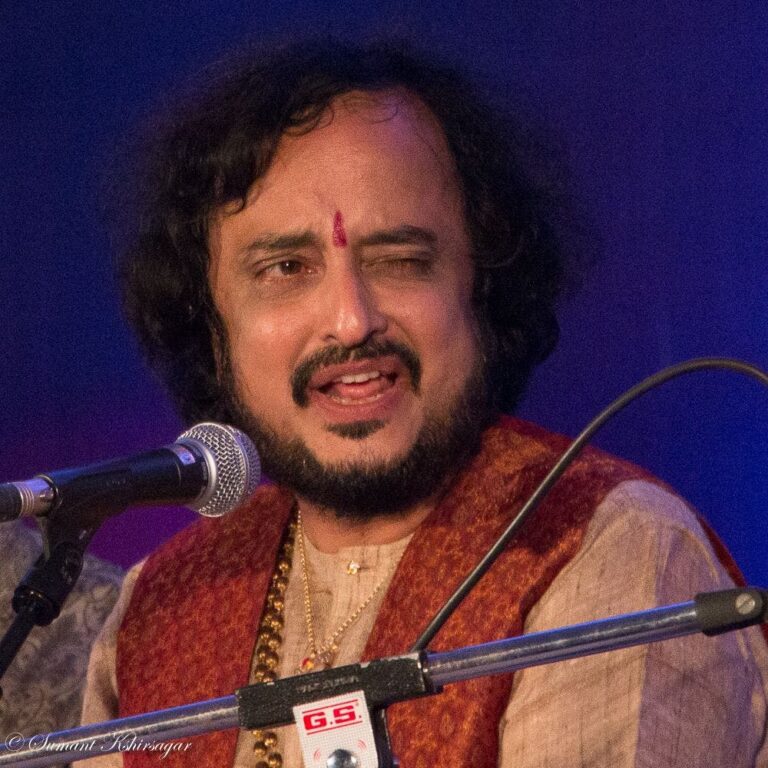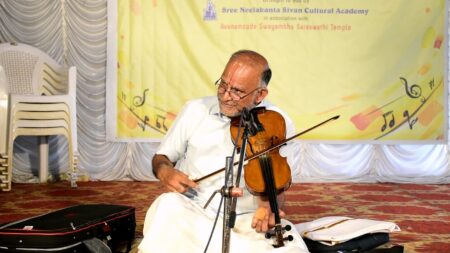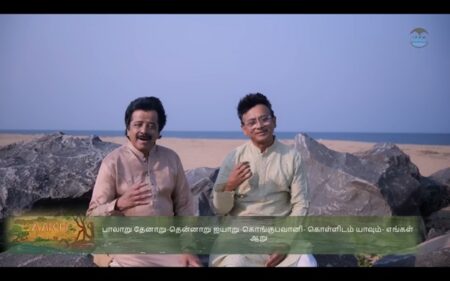His raga rendition is marked by natural phirat, fast tans, infallible rhythm and imaginative content.
There should be something musical about the soil in Karnataka’s Dharwad, Belgaum (now, Belagavi) and Hubli (now, Hubballi) towns. It has produced Hindustani musical legends such as Pandit Bhimsen Joshi, Mallikarjun Mansur, Gangubai Hangal and Basavraj Rajguru.
Pandit Kaivalyakumar Gurav is among the younger generation of Hindustani musicians who carry on this glorious tradition with his unique and innovative approach towards Indian classical music, and its teaching.
Gurav’s grandfather Pandit Ganpatrao Gurav was a disciple of Bhaskarbua Bakhle and Ustad Abdul Karim Khan; and, his father Pandit Sangameshwar Gurav, too, was an accomplished singer. However, Kaivalyakumar Gurav was attracted to Indian classical music only in his late teens. “Since I studied in a convent school, there was little encouragement for classical music,” Gurav recalls. ”But, I used to sing English songs, and win competitions too.”. Another reason that kept him away from classical music was the fact that classical musicians used to sing with tense, unfriendly expressions on their faces.
“I have always believed that music is for pleasure and peace, and so these should come through one’s singing.” It was Marathi Natya sangeet that opened the doors of classical music to him. “My father was my guru, and he was so strict when coaching so that I would forget the fact that he was my father. Whenever I made a mistake while singing, he would pinch me hard, but he would not tell me what had gone wrong. During the training sessions, he would repeat the bandish twice or thrice, but the rest of the things he would only sing one time. I had to find out for myself what was right and what was wrong.
“My father would make me sit in another room so that I would not imitate his actions as a singer. He would ask me to watch how he developed a raga. Those initial days were tough as everything he taught me passed over my head. To help me gain clarity in my notes in general and taan in particular, he made me practice singing with lips closed for around six months. These rigorous practices helped me in my self-discovery.”
Innovation within Tradition
“I have always believed that every artist should contribute something to the tradition, and not be restricted by it,” says Gurav. The Kirana Gharana of Hindustani music is well-known for the detailed development of each important note in a raga.
“One should learn to build an aura around each note, then the notes get enlightened. Once that happens, your note achieves siddhi, and the ultimate stage for an artist is to reach the swara samadhi. In Kirana Gharana, we emphasise that one should first see/feel the note. Even while developing a raga, we first seek the permission of each note, just like calling up someone before visiting his home. To do this, we try to find out the exact shruti of the note in the given raga by touching it in different ways, and after a few such phrases, we do full nyasa on it.” Gurav explains.
Gurav is an expert not only in rendering special Kirana Gharana favourites such as Shudha Kalyan, Abhogi, Malkauns, etc., but also in singing ragas from other Gharanas. “In the past, people would offer a single flower (as a token of love or appreciation) but these days they offer a bouquet. Our world of classical music is very small, and if we fight among ourselves, it becomes even more harmful. Each Gharana has its own set of favourite ragas, but we can mould them by our style and thus make them more effective.
“There is no such thing as a raga that belongs to only a particular Gharana. My grandfather learned the music of Gwalior, Agra, Jaipur, and Kirana Gharana, and collected a great number of compositions in many ragas. I try to sing other Gharana ragas like Savani, Chayanat, etc., and bring the beauty of other Gharanas into my music.”
It is often said that a raga has a particular rasa (mood), but Gurav disagrees with this. “A certain mood indeed sounds good at certain times, but depending upon the mood of an artist, and that of the audience, or the given atmosphere at a place, the mood of raga can be changed by changing the style of rendition. A meditative raga-like Darbari Kanada can be made playful, while a sad raga-like Marwa can be made joyful.”
A Passionate Teacher
Gurav has adopted a unique approach to teaching music in a relatively short time. “Often our great masters tell us to imagine the possibilities in a raga for the effective rendition of Khayals. However, it is extremely difficult for a beginner to imagine these. I tell my students that Khayal is just like the game of questions and answers. You can ask questions on any note of the raga, but your answer would be the notes Sa and Pa. The more questions you ask, the more of itself the raga will reveal. We need to pronounce the words of any composition, and bring their emotions into our music,” he says.
To master a raga, one must know many compositions in that raga, as each of them shows different approaches towards the same. Due to this, each composition in the same raga, demands different kinds of presentation. The student should be able to sing each Palta/phrase in all vowels.
Every day, after singing a raga, one should analyse one’s rendition, and find out what more could be done. According to him, a musician is just like an architect. “Today, he builds something in a given raga and tomorrow he demolishes it to build something new, in the same raga. I took music lessons from Pandit Mallikarjun Mansur for a while. He sang raga Multani for a week and each rendition was different from the previous one. This could happen because he would surrender himself to the raga. When a singer loses all his ego, the raga starts to reveal itself,” believes Gurav.
Gurav also emphasises the need for developing a voice culture, and for practising Yoga. “Ustad Abdul Karim Khan, the founder of Kirana Gharana, believed in Omkar Sadhana. I learned it, from a renowned Guru, who also taught me different pranayams to improve my voice. For lower octaves, I ask my students to do Bhramari Pranayam; for higher octaves, there are other Pranayams,” he says.
He believes that pranayams help in developing base voice, chest voice, and head voice so that they can easily sing any form of music and there are other pranayams for improving the concentration, too. “Musicians must regularly practice yoga, dhyan and pranayam; they should also be physically fit. Above all, one should be loyal to oneself. The singer should be well aware of his/her positive and negative points. Once you are aware of your weaknesses, then focus on mitigating them. No need to dwell too much on your strengths, because they will be there always.” he sums up.




